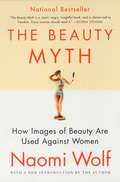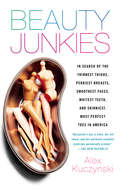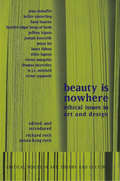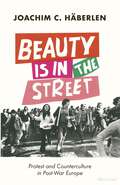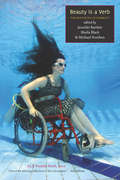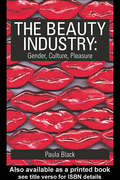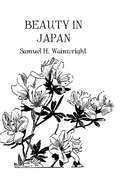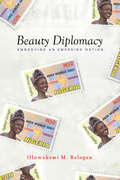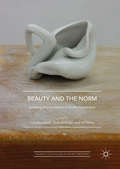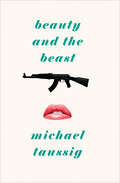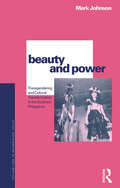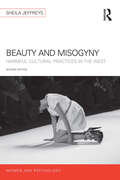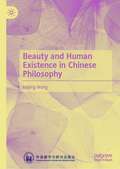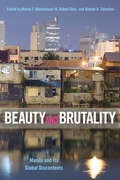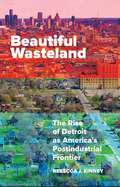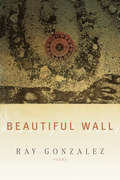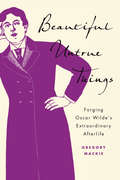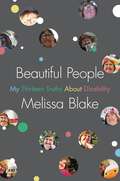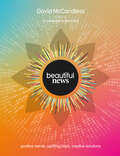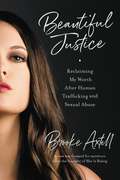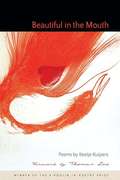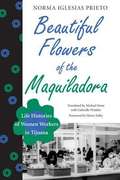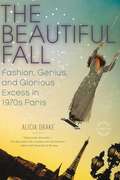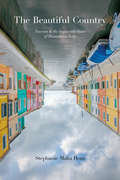- Table View
- List View
The Beauty Myth
by Naomi Wolf<P>The bestselling classic that redefined our view of the relationship between beauty and female identity. <P>In today's world, women have more power, legal recognition, and professional success than ever before. <P>Alongside the evident progress of the women's movement, however, writer and journalist Naomi Wolf is troubled by a different kind of social control, which, she argues, may prove just as restrictive as the traditional image of homemaker and wife. <P>It's the beauty myth, an obsession with physical perfection that traps the modern woman in an endless spiral of hope, self-consciousness, and self-hatred as she tries to fulfill society's impossible definition of "the flawless beauty."
Beauty Junkies
by Alex KuczynskiA star writer for the New York Times Styles section captures the follies, frauds, and fanaticism that fuel the American pursuit of youth and beauty in a wickedly revealing excursion into the burgeoning business of cosmetic enhancement. Americans are aging faster and getting fatter than any other population on the planet. At the same time, our popular notions of perfect beauty have become so strict it seems even Barbie wouldn't have a chance of making it into the local beauty pageant. Aging may be a natural fact of life, but for a growing number of Americans its hallmarks--wrinkles, love handles, jiggling flesh--are seen as obstacles to be conquered on the path to lasting, flawless beauty. In Beauty Junkies Alex Kuczynski, whose sly wit and fearless reporting in the Times has won her fans across the country, delivers a fresh and irresistible look at America's increasingly desperate pursuit of ultimate beauty by any means necessary. From a group of high-maintenance New York City women who devote themselves to preserving their looks twenty-four hours a day, to a "surgery safari" in South Africa complete with "after" photographs of magically rejuvenated patients posing with wild animals, to a podiatrist's office in Manhattan where a "foot face-lift" provides women with the right fit for their $700 Jimmy Choos, Kuczynski portrays the all-American quest for self-transformation in all its extremes. In New York, lawyers become Botox junkies in an effort to remain poker-faced. In Los Angeles, women of an uncertain age nip and tuck their most private areas, so that every inch of their bodies is as taut as their lifted faces. Across the country, young women graduating from high school receive gifts of breast implants - from their parents. As medicine and technology stretch the boundaries of biology, Kuczynski asks whether cosmetic surgery might even be part of human evolution, a kind of cosmetic survival of the fittest - or firmest? With incomparable portraits of obsessive patients and the equally obsessed doctors who cater to their dreams,Beauty Junkiesexamines the hype, the hope, and the questionable ethics surrounding the advent of each new miraculous technique. Lively and entertaining, thought-provoking and disturbing,Beauty Junkiesis destined to be one of the most talked-about books of the season.
Beauty is Nowhere: Ethical Issues in Art and Design (Critical Voices in Art, Theory and Culture)
by Saul OstrowThis book is an important addition to the discourse on contemporary ethical issues in art and design. Beauty is Nowhere makes a timely contribution to the necessary explanation of the relationship of ethics to art and design practice, and the ability of the arts to matter as we approach the next millennium. From informal discussion to formal essay, distinguished theoreticians and practitioners of art explore issues of political space, user- centred design, the social responsibility of the artist, design legislation, cultural hierarchy, modernism as colonialism, and the ethical opportunities and minefields of postmodernism. This volume grew out of a thematic lecture series: Ethical Issues in Art and Design sponsored by the Centre for Interdisciplinary Studies in Art and Design, College of the Arts, The Ohio State University.
Beauty is in the Street: Protest and Counterculture in Post-War Europe
by Joachim C. Häberlen'A rich and readable account of left-wing activism in the West and opposition to Soviet-style communism in the East' Katja Hoyer, The Spectator'A dream, perhaps, but one that still sounds worth fighting for, even beautiful' Stuart Jeffries, The Observer'An ambitious and masterly account of utopian protest in Europe ... Fast-paced, with an eye for telling detail and written with a light touch' Robert GildeaIn post-war Europe, protest was everywhere. On both sides of the Iron Curtain, from Paris to Prague, Milan to Wroclaw, ordinary people took to the streets, fighting for a better world. Their efforts came to a head most dramatically in 1968 and 1989, when mass movements swept Europe and rewrote its history.In the decades between, Joachim C. Häberlen argues, new movements emerged that transformed the nature of protesting. Activism moved beyond traditional demonstrations, from squatting to staging 'happenings' and camping out at nuclear power plants. People protested in the way they dressed, the music they listened to, the lovers they slept with, the clubs where they danced all night. New movements were born, notably anti-racism, women's liberation, gay liberation, and environmentalism. And protest turned inward, as activists experimented with new ways of living and feeling, from communes to group therapy, in their efforts to live a better life in the here and now.Some of these struggles succeeded, others failed. But successful or not, their history provides a glimpse into roads not taken, into futures that did not happen. The stories in Häberlen's book invite us to imagine different futures; to struggle, to fail, and to try again. In a time when we are told that there are no alternatives, they show us that there could be another way.
Beauty is a Verb
by Michael Northen Sheila Black Jennifer Bartlett<b>Chosen by the American Library Association as a 2012 Notable Book in Poetry.</b> <P>Beauty is a Verb is a ground-breaking anthology of disability poetry, essays on disability, and writings on the poetics of both. Crip Poetry. Disability Poetry. Poems with Disabilities. This is where poetry and disability intersect, overlap, collide and make peace. <P> Sheila Black is a poet and children's book writer. In 2012, Poet Laureate Philip Levine chose her as a recipient of the Witter Bynner Fellowship. <P> Disability activist Jennifer Bartlett is a poet and critic with roots in the Language school. <P>Michael Northen is a poet and the editor of Wordgathering: A Journal of Poetics and Disability.
The Beauty Industry: Gender, Culture, Pleasure
by Paula BlackThe beauty industry is now a multinational, multi-million dollar business. In recent years its place in contemporary culture has altered hugely as salons have become not simply places to have your hair cut or your nails done, but increasingly sites of physical and even spiritual therapy. In this fascinating and nuanced study, Paula Black strips away many popular assumptions about the beauty industry, including the one that says it exploits people's insecurity by projecting an illusory beauty myth. The interviews in this book - both with the beauty industry's workers and its clients - reveal a far more complex and interesting picture, and, in their presentation, Black re-formulates many feminist debates around choice and constraint. The debates addressed include issues around the body; the construction and maintenance of gender identity; changing definitions of health and well-being; and labour processes.
Beauty In Japan
by WainwrightFirst published in 2005. Routledge is an imprint of Taylor & Francis, an informa company.
Beauty Diplomacy: Embodying an Emerging Nation (Globalization in Everyday Life)
by Oluwakemi M. BalogunEven as beauty pageants have been critiqued as misogynistic and dated cultural vestiges of the past in the US and elsewhere, the pageant industry is growing in popularity across the Global South, and Nigeria is one of the countries at the forefront of this trend. In a country with over 1,000 reported pageants, these events are more than superficial forms of entertainment. Beauty Diplomacy takes us inside the world of Nigerian beauty contests to see how they are transformed into contested vehicles for promoting complex ideas about gender and power, ethnicity and belonging, and a rapidly changing articulation of Nigerian nationhood. Drawing on four case studies of beauty pageants, this book examines how Nigeria's changing position in the global political economy and existing cultural tensions inform varied forms of embodied nationalism, where contestants are expected to integrate recognizable elements of Nigerian cultural identity while also conveying a narrative of a newly-emerging, globally-relevant Nigeria. Oluwakemi M. Balogun critically examines Nigerian pageants in the context of major transitions within the nation-state, using these events as a lens through which to understand Nigerian national identity and international relations.
Beauty and the Norm: Debating Standardization In Bodily Appearance (Palgrave Studies In Globalization And Embodiment Ser.)
by Ulf Vierke Sarah Böllinger Claudia LiebeltRecent decades have seen the rise of a global beauty boom, with profound effects on perceptions of bodies worldwide. Against this background, Beauty and the Norm assembles ethnographic and conceptual approaches from a variety of disciplines and across the globe to debate standardization in bodily appearance. Its contributions range from empirical research to exploratory conversations between scholars and personal reflections. Bridging hitherto separate debates in critical beauty studies, cultural anthropology, sociology, the history of science, disability studies, gender studies, and critical race studies, this volume reflects upon the gendered, classed, and racialized body, normative regimes of representation, and the global beauty economy.
Beauty and the Beast
by Michael TaussigThe celebrated anthropologist and author of The Corn Wolf examines the Colombian culture of plastic surgery and its surprising relationship to violence. Drawing on extensive fieldwork in Colombia, Michael Taussig scrutinizes the audacious and sometimes destructive attempts people make to transform their bodies through cosmetic surgery and liposuction. He balances an examination of surgeries meant to enhance an individual&’s beauty with their often-overlooked counterparts, surgeries performed—often on high profile criminals—to disguise one&’s identity. Exploring this global phenomenon through Colombia&’s economic, cultural, and political history, Taussig links the country&’s long civil war and history of torture to the beauty industry at large, sketching Colombia as a country whose high aesthetic stakes make it a staging ground for some of the most important and problematic ideas about the body. Central to Taussig&’s examination is George Bataille&’s notion of depense, or &“wasting.&” While depense is often used as a critique, Taussig also looks at its position as a driving economic force. Depense, he argues, is precisely what these procedures are about, and the beast on the other side of beauty should not be dismissed as simple recompense. At once theoretical and colloquial, public and intimate, Beauty and the Beast is a true-to-place ethnography that tells a layered story about the lengths to which people will go to be physically remade.
Beauty and Power: Transgendering and Cultural Transformation in the Southern Philippines (Explorations in Anthropology)
by Mark JohnsonThis compelling study of gender and sexual diversity in the Southern Philippines addresses general questions about the relationship between the making of gender and sexualities, the politics of national and ethnic identities and processes of cultural transformation in a world of contract labourers and transnational consumers. The book focuses, in particular, on the meaning and experience of local 'gays' -- transvestite/transgender-homosexual men -- who are at once celebrated as purveyors of beauty (defined in terms of a global American otherness) and valorized as impotent men and defiled women. In short, America functions both as a sign of their abjected status and as a space for imagining and reformulating various gendered identities. This innovative work -- one of the first ethnographic studies to be published in the aftermath of the region's civil unrest -- will be of interest to anyone working on gender, the body and sexuality. Not only does it extend the boundaries of cross-cultural studies of non-mainstream genders and sexualities by directly engaging the entanglement of local sensibilities with global images and discourse, but it also demonstrates that there is nothing ambiguous about ambiguity -- gendered, sexual or otherwise. Rather, this ambiguity is the specific product of different historical relations of power through which various cultural subjects are created and re-create themselves.
Beauty and Misogyny: Harmful cultural practices in the West (Women and Psychology)
by Sheila JeffreysThe new edition of Beauty and Misogyny revisits and updates Sheila Jeffreys' uncompromising critique of Western beauty practice and the industries and ideologies behind it. Jeffreys argues that beauty practices are not related to individual female choice or creative expression, but represent instead an important aspect of women's oppression. As these practices have become increasingly brutal and pervasive, the need to scrutinize and dismantle them is if anything more urgent now as it was in 2005 when the first edition of the book was published. The United Nations concept of "harmful traditional/cultural practices" provides a useful lens for the author to advance her critique. She makes the case for including Western beauty practices within this definition, examining their role in damaging women's health, creating sexual difference and enforcing female deference. First-wave feminists of the 1970s criticized pervasive beauty regimes such as dieting and depilation, but a later argument took hold that beauty practices were no longer oppressive now that women could "choose" them. In recent years the reality of Western beauty practices has become much more bloody and severe, requiring the breaking of skin and the rearrangement or amputation of body parts. Beauty and Misogyny seeks to make sense of why beauty practices have not only persisted but become more extreme. It examines the pervasive use of makeup, the misogyny of fashion and high-heeled shoes, and looks at the role of pornography in the creation of increasingly popular beauty practices such as breast implants, genital waxing, surgical alteration of the labia and other forms of self-mutilation. The book concludes by considering how a culture of resistance to these practices can be created. A new and thoroughly updated edition of this essential work will appeal to all levels of students and teachers of gender studies, cultural studies and feminist psychology, and to anyone with an interest in feminism, women and beauty, and women's health.
Beauty and Human Existence in Chinese Philosophy
by Keping WangThis book considers the Chinese conception of beauty from a historical perspective with regard to its significant relation to human personality and human existence. It examines the etymological implications of the pictographic character mei, the totemic symbolism of beauty, the ferocious beauty of the bronzeware. Further on, it proceeds to look into the conceptual progression of beauty in such main schools of thought as Confucianism, Daoism and Chan Buddhism. Then, it goes on to illustrate through art and literature the leading principles of equilibriumharmony, spontaneous naturalness, subtle void and synthetic possibilities. It also offers a discussion of modern change and transcultural creation conducted with particular reference to the theory of the poetic state par excellence (yi jing shuo) and that of art as sedimentation (ji dian shuo).
Beauty and Brutality: Manila and Its Global Discontents
by Martin F. Manalansan IV, Robert Diaz, and Rolando B. TolentinoBeauty and Brutality provides an exciting, original, and critical encounter with this labyrinthine city’s imagined and material landscape. The authors and contributors investigate the “messy, fleshy, recalcitrant, mercurial, and immeasurable qualities of the city,” examining its urban space and smell: how it is represented in films, literature, music, and urban streetart; how it has endured the politics of colonialism, U.S. imperialism, neoliberalism, and globalization; as well as how its queer citizens engage with digital media platforms to communicate and connect with each other. The first volume to offer a cultural and urban studies approach to Manila, Beauty and Brutality considers the tensions of the Filipino diaspora as they migrate and “re-turn,” as well as the citizens’ responses to the Marcos (and post-Marcos) dictatorship, President Duterte’s authoritarianism, and “Drug War.” Essays also map out of geographies of repression and resistance in the urban war of classes, genders and sexualities, ethnicities and races, and generations, along with the violence of urban life and growth. Ultimately, Beauty and Brutality frames Manila as a vibrant and ever-evolving metropolis that, even in the face of its difficulties, instills hope. Contributors: Paul Michael Leonardo Atienza, Christine Bacareza Balance, Vanessa Banta, Rosa Cordillera A. Castillo, Roland Sintos Coloma, Gary C. Devilles, Faith R. Kares, John B. Labella, Raffy Lerma, Bliss Cua Lim, Ferdinand M. Lopez, Paul Nadal, Jema M. Pamintuan, Oscar Tantoco Serquiña, Jr., Louise Jashil R. Sonido, and the editors.
Beautiful Wasteland: The Rise of Detroit as America's Postindustrial Frontier
by Rebecca J. KinneyAccording to popular media and scholarship, Detroit, the once-vibrant city that crumbled with the departure of the auto industry, is where dreams can be reborn. It is a place that, like America itself, is gritty and determined. It has faced the worst kind of adversity, and supposedly now it's back. But what does this narrative of "new Detroit" leave out? Beautiful Wasteland reveals that the contemporary story of Detroit's rebirth is an upcycled version of the American Dream, which has long imagined access to work, home, and upward mobility as race-neutral projects. They're not. As Rebecca J. Kinney shows, the narratives of Detroit's rise, decline, and potential to rise again are deeply steeped in material and ideological investments in whiteness. By remapping the narratives of contemporary Detroit through an extension of America's frontier mythology, Kinney analyzes a cross-section of twentieth and twenty-first century cultural locations--an Internet forum, ruin photography, advertising, documentary film, and print and online media. She illuminates how the stories we tell about Detroit as a frontier of possibility enable the erasure of white privilege and systemic racism. By situating Detroit as a "beautiful wasteland," both desirable and distressed, this shows how the narrative of ruin and possibility form a mutually constituted relationship: the city is possible precisely because of its perceived ruin.Beautiful Wasteland tackles the key questions about the future of postindustrial America. As cities around the country reckon with their own postindustrial landscapes, Rebecca Kinney cautions that development that elides considerations of race and class will only continue to replicate uneven access to the city for the poor, working class, and people of color.
Beautiful Wall
by Ray GonzalezBeautiful Wall takes us on a profound journey through the deserts of the Southwest where the ever-changing natural landscape and an aggressive border culture rewrite intolerance and ethnocentric thought into human history. Inextricably linked to his Mexican ancestry and American upbringing, Ray Gonzalez's new collection mounts the wall between the current realities of violence and politics, and a beautiful, never-to-be-forgotten past.Ray Gonzalez is the author of fifteen books of poetry. The recipient of numerous awards, including a 2002 Lifetime Achievement Award from the Southwest Border Regional Library Association, he is a professor at the University of Minnesota in Minneapolis, Minnesota.
Beautiful Untrue Things: Forging Oscar Wilde’s Extraordinary Afterlife
by Gregory MackieBorrowing its title from Oscar Wilde’s essay "The Decay of Lying," this study engages questions of fraudulent authorship in the literary afterlife of Oscar Wilde. The unique cultural moment of Wilde’s early-twentieth-century afterlife, Gregory Mackie argues, afforded a space for marginal and transgressive forms of literary production that, ironically enough, Wilde himself would have endorsed. Beautiful Untrue Things recovers the careers of several forgers who successfully inhabited the persona of the Victorian era’s most infamous homosexual and arguably its most successful dramatist. More broadly, this study tells a larger story about Oscar Wilde’s continued cultural impact at a moment when he had fallen out of favour with the literary establishment. It probes the activities of a series of eccentric and often outrageous figures who inhabited Oscar Wilde’s much-mythologized authorial persona – in forging him, they effectively wrote as Wilde – in order to argue that literary forgery can be reimagined as a form of performance. But to forge Wilde and generate "beautiful untrue things" in his name is not only an exercise in role-playing – it is also crucially a form of imaginative world-making, resembling what we describe today as fan fiction.
Beautiful People: My Thirteen Truths About Disability
by Melissa BlakeWell-known disability activist and social media influencer Melissa Blake offers a frank, illuminating memoir and a call to action for disabled people and allies. In the summer of 2019, journalist Melissa Blake penned an op-ed for CNN Opinion. A conservative pundit caught wind of it, mentioning Blake&’s work in a YouTube video. What happened next is equal parts a searing view into society, how we collectively view and treat disabled people, and the making of an advocate. After a troll said that Blake should be banned from posting pictures of herself, she took to Twitter and defiantly posted three smiling selfies, all taken during a lovely vacation in the Big Apple:I wanted desperately to clap back at these vile trolls in a way that would make a statement, not only about how our society views disabilities, but also about the toxicity of our strict and unrealistic beauty standards. Of course I knew that posting those selfies wasn't going to erase the nasty names I'd been called and, the chances were, they would never even see my tweet, but that didn't matter. I wasn't doing it for them; I was doing it for me and every single disabled person who has been bullied before, online and in real life. When people mock how I look, they're not just insulting me. They're insulting all disabled people. We're constantly told that we're repulsive and ugly and not good enough to be seen. This was me pushing back against that toxic, ableist narrative.For the first time, I felt like I was doing something empowering, taking back my power and changing the story. Her tweet went viral, attracting worldwide media attention and interviews with the BBC, USA Today, the Chicago Tribune, PEOPLE magazine, Good Morning America and E! News. Now, in her manifesto, Beautiful People, Blake shares her truths about disability, writing about (among other things): the language we use to describe disabled people ableism, microaggressions, and their pernicious effects what it's like to live in a society that not only isn't designed for you, but actively operates to render you invisible her struggles with self‑image and self‑acceptance the absence of disabled people in popular culture why disabled people aren't tragic heroes Blake also tells the stories of some of the heroes of the disability rights movement in America, in doing so rescuing their incredible achievements from near total obscurity. Highlighting other disabled activists and influencers, Blake&’s work is the calling card of a powerful voice—one that has sparked new, different, better conversations about disability.
Beautiful News: Positive Trends, Uplifting Stats, Creative Solutions
by David McCandlessIn this sequel to bestselling The Visual Miscellaneum, author David McCandless reveals unexpected—and much needed—positive developments from around the world.David McCandless creates simple, elegant ways to see and understand complex, abstract, and often obscured information important to our lives. A specialist in infographics. McCandless cuts through the noise of data overload, creating visually stunning displays that not only make facts comprehensive, but illuminates their connections and adds context, making information meaningful in beautiful and entertaining way.Designed in David McCandless’s signature style. Beautiful News focuses on fascinating positive developments at a time when the world has never seemed more dangerous and unpredictable. McCandless draws from philosophy, spirituality, ecology, society, technology, history, science, economics, and pop culture, to reveal positive trends and developments, from the invention of a breakthrough device that uses ocean forces to clean plastic from the world’s seas, to a new method of converting donated blood to the crucial “O” negative type that can be used universally.In cutting edge graphs, charts, and illustrations, David McCandless creatively visualizes unexpected and compelling relationships between diverse data sets. Among his surprising findings: almost 250 US cities have remained in the Paris Accord; there are more female CEOs in the world than ever before; a new vaccine has been developed to help protect bees; Zika is disappearing from the Americas.At a time when we are besieged by disturbing events, Beautiful News is the antidote to brighten the darkest day—a shot of positivity and good cheer that will lift the spirts and provide sorely needed hope about our world in a way never before seen.
Beautiful Justice: Reclaiming My Worth After Human Trafficking and Sexual Abuse
by Brooke AxtellA story of healing and a guide to seeking justice after sexual abuse from Brooke Axtell, one of the foremost survivor experts on sexual assault, domestic violence, and human traffickingWhen Brooke Axtell was seven years old, her nanny subjected her to sex trafficking. Today, she is a champion and advocate for women around the world who have experienced sexual violence and trauma.Beautiful Justice shares Brooke's own gripping story, both the trauma of sex trafficking and also her pathway through healing, moving on, and reclaiming power. Along the way, she imparts warm wisdom for others who have experienced similar violence, providing lessons from her own life and from the thousands of women, advocates, and lawmakers she's spoken with. Relying on her own experiences and a keen awareness of public policy, she provides a clear-eyed awareness of the ways that our culture and government work against women experiencing violence around the world. Inspiring and powerfully redemptive, Brooke encourages readers to take part in a creative resistance as a path to justice.
Beautiful in the Mouth (A. Poulin, Jr. New Poets of America)
by Keetje KuipersThomas Lux selected this debut collection as winner of BOA&’s A. Poulin, Jr., Poetry Prize. In his foreword he writes, "I was immediately struck by the boldness of imagination, the strange cadences, and wild music of these poems. We should be glad that young poets like Keetje Kuipers are making their voices heard not by tearing up the old language but by making the old language new."Keetje Kuipers, a native of the Northwest, earned her BA at Swarthmore College and MFA at the University of Oregon. A Stegner Fellow at Stanford University, she divides her time between Stanford and Missoula, Montana.
Beautiful in the Mouth
by Keetje Kuipers Thomas LuxThomas Lux selected this debut collection as winner of BOA's A. Poulin, Jr., Poetry Prize. In his foreword he writes, "I was immediately struck by the boldness of imagination, the strange cadences, and wild music of these poems. We should be glad that young poets like Keetje Kuipers are making their voices heard not by tearing up the old language but by making the old language new."Keetje Kuipers, a native of the Northwest, earned her BA at Swarthmore College and MFA at the University of Oregon. A Stegner Fellow at Stanford University, she divides her time between Stanford and Missoula, Montana.
Beautiful Flowers of the Maquiladora: Life Histories of Women Workers in Tijuana
by Iglesias Prieto NormaPublished originally as La flor mas bella de la maquiladora, this beautifully written book is based on interviews the author conducted with more than fifty Mexican women who work in the assembly plants along the U. S. –Mexico border. A descriptive analytic study conducted in the late 1970s, the book uses compelling testimonials to detail the struggles these women face. The experiences of women in maquiladoras are attracting increasing attention from scholars, especially in the context of ongoing Mexican migration to the country’s northern frontier and in light of the North American Free Trade Agreement (NAFTA). This book is among the earliest accounts of the physical and psychological toll exacted from the women who labor in these plants. Iglesias Prieto captures the idioms of these working women so that they emerge as dynamic individuals, young and articulate personalities, inexorably engaged in the daily struggle to change the fundamental conditions of their exploitation.
The Beautiful Fall: Fashion, Genius, and Glorious Excess in 1970s Paris
by Alicia Drake"Deliciously dramatic... The Beautiful Fall crackles with excitement."-New York Times Book Review In the 1970s, Paris fashion exploded like a champagne bottle left out in the sun. Amid sequins and longing, celebrities and aspirants flocked to the heart of chic, and Paris became a hothouse of revelry, intrigue, and searing ambition. At the center of it all were fashion's most beloved luminaries - Yves Saint Laurent, the reclusiveenfant terrible,and Karl Lagerfeld, the flamboyant freelancer with a talent for reinvention - and they divided Paris into two fabulous halves. Their enduring rivalry is chronicled in this dazzling exposé of an era: of social ambitions, shared obsessions, and the mesmerizing quest for beauty. "Fascinating." - New York Times "Addictive." - Philadelphia Inquirer "It's like US Weekly, 1970s style." - Gotham "A story constructed as exquisitely as a couture dress. . . . It moves stylishly forward, with frequent over-the-shoulder glances at some very dishy background." - Boston Globe
The Beautiful Country: Tourism and the Impossible State of Destination Italy
by Stephanie Malia HomEvery year, Italy swells with millions of tourists who infuse the economy with billions of dollars and almost outnumber Italians themselves. In fact, Italy has been a model tourist destination for longer than it has been a modern state. The Beautiful Country explores the enduring popularity of “destination Italy,” and its role in the development of the global mass tourism industry. Stephanie Malia Hom tracks the evolution of this particular touristic imaginary through texts, practices, and spaces, beginning with the guidebooks that frame Italy as an idealized land of leisure and finishing with destination Italy’s replication around the world. Today, more tourists encounter Italy through places like Las Vegas’s The Venetian Hotel and Casino or Dubai’s Mercato shopping mall than experience the country in Italy itself. Using an interdisciplinary methodology that includes archival research, ethnographic fieldwork, literary criticism, and spatial analysis, The Beautiful Country reveals destination Italy’s paramount role in the creation of modern mass tourism.
